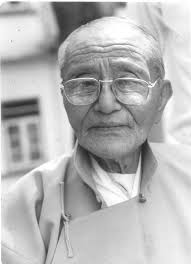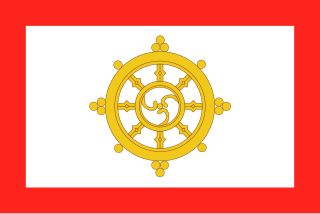| |||||||||||||||||||||
18 of the 24 seats in the State Council | |||||||||||||||||||||
|---|---|---|---|---|---|---|---|---|---|---|---|---|---|---|---|---|---|---|---|---|---|
| |||||||||||||||||||||
General elections were held in Sikkim in January 1973. [1] [2] The Sikkim National Party emerged as the largest party, winning nine of the 18 elected seats. [3]
| |||||||||||||||||||||
18 of the 24 seats in the State Council | |||||||||||||||||||||
|---|---|---|---|---|---|---|---|---|---|---|---|---|---|---|---|---|---|---|---|---|---|
| |||||||||||||||||||||
General elections were held in Sikkim in January 1973. [1] [2] The Sikkim National Party emerged as the largest party, winning nine of the 18 elected seats. [3]
The State Council was established in 1953 by the Chogyal. [4] It originally had 18 members, of which 12 were elected and six (including the President) appointed by the Chogyal. [4] Of the 12 elected members, six were for the Nepali community and six for the Lepcha and the Bhutia communities. [4] For the 1958 elections the number of seats was increased to 20 by adding one seat for the Sangha and an additional appointed member. [4] In 1966 a further four seats had been added; one each for the Nepali and Lepcha/Bhutia communities, together with one for the Tsong and a scheduled caste seat. [5]
Candidates for election to the Council had to be at least 30 years old, whilst the voting age was set at 21. [4]
The election schedule was announced by the Election Commission on 23 September 1972. [6] : 3–65
| # | Poll Event | Date |
|---|---|---|
| 1 | Publication of final electoral rolls | 24 October 1972 |
| 2 | Last Date for filing nomination | 31 October 1972 |
| 3 | Last date for withdrawal of nominations | 25 November 1972 |
| 4 | Polling - Phase 1 (West, South districts) | 10 January 1973 |
| Polling - Phase 2 (Gangtok, East, North districts) | 23 January 1973 | |
| 5 | Date of Counting | 29 January 1973 |
| 6 | Announcement of Results | 15 February 1973 |
Prior to the elections the Sikkim State Congress and the Sikkim Janata Party merged to form the Sikkim Janata Congress. [2]
| Party | Seats | +/– | |
|---|---|---|---|
| Sikkim National Party | 9 | +1 | |
| Sikkim National Congress | 5 | +2 | |
| Sikkim Janata Congress | 2 | – | |
| Independents | 2 | – | |
| Appointed members | 6 | 0 | |
| Total | 24 | 0 | |
| Source: AC Sinha [7] | |||
In addition to the elected members, six members were appointed to the Sikkim State Council by the Chogyal on 5 March; Traten Sherba Gyaltsen, Madan Mohan Rasaily, Chhoutuk Tsering Pazo, Dhan Bahadur Chettri, Kali Prasad Rai and Atang Lepcha. [9]
Following the election, the Sikkim National Congress and Sikkim Janata Congress claimed that vote rigging took place in the South Sikkim constituency. [10] They demanded that officials involved were arrested, but these demands were not met, leading to protests. [2] The unrest led to the signing of a tripartite agreement on 8 May between the Choygal, Sikkimese political parties and the government of India. The agreement provided for the establishment of a responsible government under the supervision of a Chief Executive nominated by the Indian government.

Sikkim is a state in northeastern India. It borders the Tibet Autonomous Region of China in the north and northeast, Bhutan in the east, Koshi Province of Nepal in the west, and West Bengal in the south. Sikkim is also close to the Siliguri Corridor, which borders Bangladesh. Sikkim is the least populous and second-smallest among the Indian states. Situated in the Eastern Himalaya, Sikkim is notable for its biodiversity, including alpine and subtropical climates, as well as being a host to Kangchenjunga, the highest peak in India and third-highest on Earth. Sikkim's capital and largest city is Gangtok. Almost 35% of the state is covered by Khangchendzonga National Park – a UNESCO World Heritage Site.
The Sikkim State Congress, or SSC, was an annexationist political party in the Kingdom of Sikkim. It was founded in 1947 and worked closely with the Indian National Congress (INC) to successfully achieve the annexation of Sikkim to India. Other parties established by the INC to serve India's interests in its near abroad included the Nepal State Congress Party and the Bhutan State Congress Party.

The history of Sikkim begins with the indigenous Lepcha's contact with early Tibetan settlers. Historically, Sikkim was a sovereign Monarchical State in the eastern Himalayas. Later a protectorate of India followed by a merger with India and official recognition as a state of India. Lepchas were the main inhabitants as well as the Ruler of the land up to 1641. Lepchas are generally considered to be the first people, indigenous to Sikkim also includes Darjeeling.

Kazi Lhendup Dorjee, also spelled Lhendup Dorji or Lhendup Dorji Khangsarpa was an Indian politician who was the first chief minister of Sikkim from 1975 to 1979 after its union with India. He was the first Prime Minister of Sikkim from 1974 to 1975. He also served as the Executive Council of Sikkim from 1967 to 1970. He was a member of INC after 1975 and Sikkim National Congress before 1975.

Sikkimese are people who inhabit the Indian state of Sikkim. The dominance ethnic diversity of Sikkim is represented by 'Lho-Mon-Tsong-Tsum' that identifies origin of three races since seventeenth century. The term 'Lho' refers to Bhutias (Lhopo) means south who migrated from Southern Tibet, the term 'Mon' refers to Lepchas (Rong) lived in lower Eastern Himalayas and the term 'Tsong' refers to Limbus, another tribe of Sikkim. The pre-theocratic phase of Sikkim was inhabited by the Kiratis, “Sikkim is also known as the home of the Kirati tribesmen from the pre-historic times.Society in Sikkim is characterised by multiple ethnicity and possesses attributes of a plural society. The present population of Sikkim is composed of different races and ethnic groups, viz., the Lepchas, the Bhutias, the Nepalis and the Plainsmen, who came and settled in different phases of history. The historic 8 May agreement between Chogyal, Government of India and political parties of Sikkim defines Sikkimese as Sikkimese of Bhutia-Lepcha origin or Sikkimese of Nepali origin including Tsongs and Schedule castes. The community in Sikkim is inclusive of three sub-cultural sectors: the Kiratis, the Newaris and the Indian Gorkhas.
The indigenous people of Sikkim are the Lepchas; the naturalized ethnic populations of Limbus, Bhutias, Kiratis, & Indian Gorkha of Nepalese descendants who have an enduring presence in shaping the history of modern Sikkim. The indigeneity criteria for including all peoples of Sikkim and Darjeeling hills is a misnomer as it is clearly known that Lepchas are the first people who trace their origin and culture of their ethnogenesis to the historical and somewhat political geography of Sikkim history as is well documented by colonial and immigrant settler history. However many tribes preceded the migration of the colonial powers and can trace their migratory background as well as ancestral heritage and a well formed history of civilization and cultural locus that is not inherently indigenous to Sikkim.
General elections were held in Sikkim in May 1953. The Sikkim National Party and the Sikkim State Congress both won six seats. Voter turnout was less than 30%.
General elections were held in Sikkim in 1958. The Sikkim State Congress emerged as the largest party, winning seven of the 20 seats. Voter turnout was around 35%.
General elections were held in Sikkim in March 1967, having been due earlier but postponed after a state of emergency was declared following the Sino-Indian War. The Sikkim National Congress emerged as the largest single party, winning eight of the 24 seats. Although the Sikkim National Party won only five seats, its parliamentary faction was joined by three others.
General elections were held in Sikkim in April 1970. The Sikkim National Party emerged as the largest party, winning eight of the 24 seats.
Bhim Bahadur Gurung was the third Chief Minister of Sikkim. He held office from 11 May until 24 May 1984, the shortest term in the history of Sikkim.
General elections were held in Sikkim on 13 April 1974. They were the first elections in Sikkim to be held on the basis of universal suffrage, and also the last prior to Indian annexation. The result was a victory for the Sikkim National Congress, which won 31 of the 32 seats in the State Council. Kazi Lhendup Dorjee subsequently became Chief Minister. In May 1975 Sikkim became a state of India, at which point the State Council became the Sikkim Legislative Assembly.
Hamro Sikkim Party is a regional political party in the Indian state of Sikkim. The incumbent president of this party is Bhaichung Bhutia. Its election symbol is a Whistle.

Sangha Assembly constituency is one of the 32 assembly constituencies of Sikkim, a state in the Northeast region of India. It is a part of the Sikkim Lok Sabha constituency. As of 2019, Sonam Lama is the holder of this seat. His current term is expected to end by 2024.
The Sikkim National People's Party (SNPP) was a regional political party in the Indian state of Sikkim. Election symbol was Pen Nib. SNPP didn't have any relationship with Sikkim National Party (SNP) in same state or National People's Party (NPP) in the state of Meghalaya.
Athup Lepcha is an Indian politician and environmental activist. He is the vice president of Hamro Sikkim Party (HSP) and the president of "Affected Citizens of Teesta" (ACT), Non-governmental organization for environment and biodiversity.

Nahakul Pradhan also known as Nakul Pradhan was a Sikkimese pre-merger politician, pro-democracy leader, a member of the Sikkim State Council and Executive Council of Sikkim serving multiple terms. He was the President of the Sikkim State Congress party and the Editor of Sikkim’s first news magazine Kanchenjunga.
Bhuta-Lepcha is an ethnic grouping consisting of people of the Bhutia and Lepcha communities in Sikkim, India. Both these groups are listed as Scheduled Tribes by the Government of India.

The State Council of Sikkim was the unicameral legislature of the former Kingdom of Sikkim, which was located in the Himalayas, between India and China.
Kazis and Thikadars of Sikkim, also known as Ilakadars, were the hereditary feudal lords and the ruling class in former Kingdom of Sikkim. They had administrative and judicial powers within their respective land estates. This system existed since the establishment of the Namgyal dynasty and was further institutionalised under the period of British influence in Sikkim.
...they were supported by Peyching Lama, who had been elected un-contested from the monasteries...
The defeated parties alleged polling in Rabong in South Sikkim was rigged in the favour of the SNP candidate